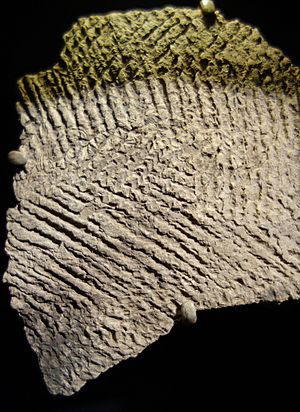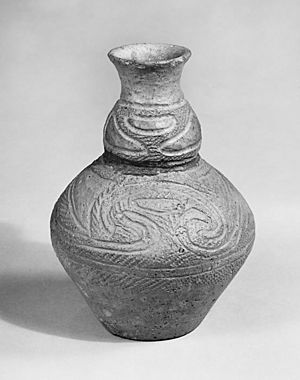Cord-marked pottery facts for kids

Cord-marked pottery is a very old type of simple clay pot. People made it in villages long before modern times. These pots were super useful for storing food and cooking it over a fire. The way cord-marked pottery looked changed a bit depending on where it was made. This was because different places had different kinds of clay and materials. Making these pots usually started when people began to farm and live in one place. This was different from a hunter-gatherer lifestyle, where people moved around a lot.
Contents
How People Made Cord-Marked Pottery
People would find clay from hillsides or streams. They then added other things to the clay. These could be shells, small stones, sand, plant fibers, or even crushed pieces of old pottery. Adding these things is called "tempering" the clay. It stopped the pots from cracking or shrinking when they dried and were heated.
Potters used a few ways to shape the pots. They could pinch and shape a lump of clay. Another way was "paddling," where they hit a lump of clay with a wooden paddle against a stone. If the paddle had fabric on it, the pot would get a fabric texture. The third way was "coiling." This meant rolling clay into long ropes and stacking them up. Then, they would pinch, thin, and smooth the clay coils together.
To make the cord marks, people used a special "paddle and anvil" method. They would press a wooden paddle wrapped with cords against the outside of the pot. At the same time, they held a stone (the anvil) inside the pot. This helped to shape and thin the pottery walls. The cords kept the paddle from sticking to the wet clay. This process left small, parallel lines on the pot's surface. After shaping, the pottery dried for about two weeks. Then, it was heated in a fire to make it hard and strong.
The rough surface of the pottery had two main benefits. First, it made the pots easier to hold, especially if they were wet or greasy. Second, the rough texture helped heat from a cooking fire get into the food inside the pot faster than a smooth pot would.
Potters used different types of cords to make marks. Some used a single cord, others used two twisted cords. Sometimes, they even used thick cords tied into knots to create a net-like pattern on the paddle.
Cord-Marked Pottery in Asia

In Japan, a very old time period is called the Jōmon period. It's named after its special cord-marked pottery. An American named Edward S. Morse found this pottery in 1867 and gave the period its name.
In Taiwan, there was a culture called Fengpitou. They made beautiful red pottery with cord marks. This pottery has been found in places like Penghu and other parts of Taiwan. Taiwan's ancient history is divided into several periods. One of them is the Tapenkeng culture, which made rough corded pottery. Another is the fine corded ware culture, known for its red cord-marked pots.
Pottery from the Suntangpu culture often included jars, bowls, and basins. They mostly made three kinds of pottery: reddish sandy, orange sandy, and orange clay. The reddish sandy pottery, with its red coating and special minerals, is a key sign of the Suntangpu culture. Scientists can study these pots to learn what materials ancient potters used.
Cord-Marked Pottery in North America
In North America, people think cord-marked pottery first appeared in the Eastern United States before 1000 BC. It then showed up in the upper Midwestern United States around 500 BC. Over the next 500 years, the idea of making pottery spread. It went west, south, and northwest into the Great Plains, west of the Mississippi River, and into Texas and Oklahoma.
Cord-marked pottery came in many shapes. Some early pots were like an upside-down cone, with a pointed bottom. They could be up to 2.5 feet tall! These thick, heavy pots were used for storing food. They were a big improvement over just burying food in the ground.
Over time, potters became more skilled. The walls of the pots became thinner and rounder. This happened during periods like the Plains Village period (around AD 1100-1450). Round pots were easier to cook with. They could sit on small stones or directly on a fire. Pots also had different rim shapes: flared, straight, or thickened (called collared). Sometimes, people added decorations like fingernail marks or carved lines.
Different Native American groups had their own pottery styles. These styles depended on the materials they used and the decorations they added. Some groups used crushed volcanic stone to temper their clay. Others used shells to temper pottery, like the Keyser Cord-marked pottery found in ancient West Virginia.
Cord-marked pottery was made in the plains from the early centuries AD until the 1700s. For example, Wilmington Cord-Marked pottery was found near the Savannah River in North and South Carolina. The oldest Wilmington pottery dates back to 500 BC.
Another example is Borger Cordmarked Pottery. It was made by Plains Villagers about 900 years ago. This pottery is named after the town of Borger, Texas, and was found at Landergin Mesa. People of the Antelope Creek culture (AD 1100 to 1450) made it. Similar pottery has been found in Oklahoma, Kansas, and Colorado. The Apache people also made cord-marked pottery during the Tipi Ring period. This has been found at Picture Canyon in Colorado.
Images for kids
-
Yangshao cordmarked amphora, Banpo phase, 4800 BC, Shaanxi



